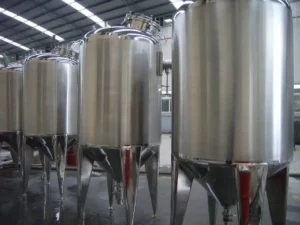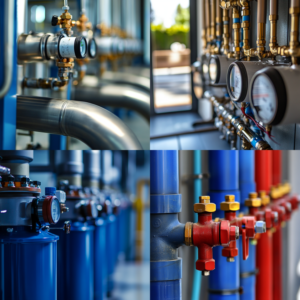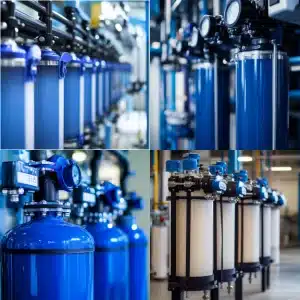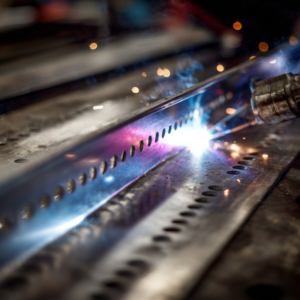
Introduction to Air Receiver Tanks
What Is an Air Receiver Tank?
An air receiver tank is more than just a component; it’s the silent hero in compressed air systems, serving as a reservoir for compressed air, stabilizing pressure levels, and smoothing out demand spikes. Think of it as a breath of fresh air for your system, ensuring everything runs smoothly and efficiently. At Red River, we understand the critical role these tanks play, which is why we pour our heart, soul, and unmatched expertise into every unit we craft.
The Importance of Air Receiver Tanks in Industrial Applications
In the bustling world of industry, every second counts and efficiency is king. Air receiver tanks stand as pillars of reliability. They’re not just equipment — they’re the backbone of operations in oil and gas, power generation, and more.
These tanks ensure that your systems have the air power they need, exactly when they need it. This prevents downtime and boosts overall performance. At Red River LLC, we understand this critical role. That’s why we deliver nothing but the best.
Brief History of Air Receiver Tank Development
Tracing the lineage of air receiver tanks reveals a story of innovation and engineering excellence. From humble beginnings, these tanks have become indispensable in modern industry.
Over time, they’ve evolved alongside advancements in technology. At Red River LLC, we honor this legacy by building every tank with the spirit of innovation. Our work is guided by American values and a strong commitment to excellence.
The Basics of Air Receiver Tank Operation
How Air Receiver Tanks Function
At the core of air receiver tanks lies a simple yet profound principle: to store compressed air and release it as needed, ensuring steady pressure and flow. This functionality is crucial for minimizing wear on compression equipment and optimizing system performance. At Red River, we design our tanks to embody this principle, delivering unparalleled functionality and reliability.
Components of an Air Receiver Tank
Every air receiver tank is a system of parts working in harmony. These include valves, gauges, drains, and safety devices.
Understanding these components is essential for maximizing efficiency and safety. At Red River LLC, we focus on every detail. Our dedication to safety and quality ensures each part is crafted to perfection.
Types of Air Receiver Tanks
Diversity in design allows air receiver tanks to meet a wide range of needs, from vertical to horizontal configurations and everything in between. Whether your operation requires a small tank for tight spaces or a large reservoir for high-demand applications, Red River has the expertise and technology to deliver solutions tailored to your specific requirements.
The Role of Air Receiver Tanks in Pressure Systems
Stabilizing Pressure Fluctuations
Imagine a world where every pressure change in your system could lead to downtime or inefficiency. That’s a world without air receiver tanks. These vessels act as reservoirs, buffering sudden changes in demand and smoothing out the operational cycle of compressed air systems. It’s this stability that allows your operations to run like a well-oiled machine, mirroring the reliability and steadfastness we value at Red River. In pressure vessel manufacturing ensures that each air receiver tank we produce is a testament to our dedication to your operational success
Enhancing the Efficiency of Compressed Air Systems
Efficiency isn’t just about doing more with less; it’s about strategic resource management, a principle deeply embedded in our work ethic at Red River. Air receiver tanks play a crucial role in maximizing the efficiency of compressed air systems. By providing a constant supply of air during peak demands and reducing the load on compressors, these tanks not only save energy but also extend the life of your equipment. It’s a perfect example of how we, at Red River, leverage our expertise in pressure vessel manufacturing to deliver solutions that not only meet but exceed your expectations.
Safety Mechanisms and Pressure Relief
Safety is not just a policy at Red River; it’s our culture. In line with our unwavering dedication to creating a safe working environment, air receiver tanks are designed with safety mechanisms, including pressure relief valves and gauges, to prevent over-pressurization and ensure operational integrity. These features are critical in maintaining a safe workplace, reflecting our commitment to not just meeting but surpassing industry safety standards. When you choose Red River, you’re choosing a partner who prioritizes your safety as much as you do.
Air Receiver Tanks in Various Industries
Application in the Oil and Gas Sector
In the demanding environments of the oil and gas industry, where precision and reliability are non-negotiable, air receiver tanks are indispensable. They ensure the smooth operation of pneumatic tools and machinery, critical in exploration, drilling, and refining processes. Our deep understanding of this sector’s unique needs allows us to design and manufacture air receiver tanks that stand up to the challenge, embodying the resilience and innovation that drive America forward.
Importance in Power Generation
Power generation is the backbone of industrial and residential life, and air receiver tanks play a silent yet crucial role in this sector. By ensuring the reliable operation of air compressors used in control systems and emergency shutdowns, these tanks contribute to the uninterrupted generation of power. At Red River, we’re proud to support this vital industry, providing solutions that help keep the lights on and the engines of progress running.
Uses in Manufacturing and Fabrication
The versatility of air receiver tanks extends into the manufacturing and fabrication sectors, where they support a wide range of applications, from pneumatic tool operation to process control. As a result, our commitment to innovation and quality at Red River means we deliver air receiver tanks that enhance productivity and reliability in these critical industries, thereby driving America’s manufacturing prowess.
Design and Manufacturing of Air Receiver Tanks
Materials Used in Construction
Choosing the right material for air receiver tanks is paramount to their performance and longevity. At Red River, we utilize high-grade carbon steel and stainless steel, selected for their durability and resistance to corrosion. In fact, our choice of materials reflects our commitment to providing products that not only meet but exceed industry standards. By doing so, we ensure that your air receiver tank will stand the test of time, even in the most demanding environments.
Design Standards and Compliance
Our design process adheres strictly to the American Society of Mechanical Engineers (ASME) standards, ensuring each air receiver tank we produce is capable of handling specified pressures safely and efficiently. Moreover, compliance with these standards is not just about meeting regulatory requirements; rather, it’s about ensuring the safety and reliability of your compressed air system. To achieve this, our team of skilled engineers employs the latest in design technology, along with their deep industry knowledge, to create air receiver tanks that are not only compliant but also optimized for your specific application.
Innovations in Air Receiver Tank Manufacturing
Innovation is at the core of what we do at Red River. Therefore, we continuously explore new manufacturing techniques and technologies to enhance the efficiency and functionality of our air receiver tanks. For example, we integrate smart monitoring systems that allow for real-time pressure and temperature tracking. In addition, we employ advanced welding techniques that ensure the integrity of the tank. Ultimately, we are always looking for ways to push the boundaries of what’s possible.
Installation and Maintenance Best Practices
Proper Installation Techniques
Our team offers expert guidance on the proper installation of air receiver tanks, ensuring they are set up in a way that optimizes their performance and safety. From selecting the ideal location to advising on the correct orientation and securing methods, we ensure that your tank is installed with precision and care.
Routine Maintenance and Inspection
Regular maintenance is crucial for the longevity and efficiency of air receiver tanks. We provide detailed maintenance schedules and checklists, tailored to the specific needs of your tank. Our recommendations cover everything from routine inspections to the cleaning of valves and gauges, ensuring your tank remains in top condition.
Identifying and Addressing Common Issues
It doesn’t end with installation, we’re here to support you throughout the life of your air receiver tank. Whether it’s diagnosing pressure fluctuations or addressing moisture build-up, our team is equipped to identify and resolve common issues swiftly, minimizing downtime and ensuring your operations run smoothly.
Safety Standards and Regulatory Compliance
Understanding ASME Standards
The American Society of Mechanical Engineers (ASME) sets the benchmark for the design, fabrication, and inspection of air receiver tanks. Our commitment to these standards is not just about compliance; it’s about ensuring the safety and reliability of every pressure vessel we manufacture. With Red River, you’re choosing a partner who values the integrity of their work as much as you value the safety of your operations.
Global Safety Protocols for Air Receiver Tanks
Safety knows no borders, and neither do we. Our air receiver tanks are designed to comply with global safety protocols, ensuring they are equipped to serve industries worldwide. Whether you’re operating in the oil and gas sector, power generation, or any of the critical industries we support, you can trust in the universal safety standards upheld by Red River’s manufacturing processes.
Ensuring Compliance in Your Operations
Compliance is a shared responsibility, and at Red River, we take this partnership seriously. Our team is dedicated to guiding you through the regulatory landscape, ensuring your air receiver tanks are not just compliant today but are positioned to meet future standards and innovations in safety and design.
Need a reliable partner?
Red River specializes in the design and manufacturing of pressure vessels. We also fabricate related items such as prefabricated spools and skid packages.
Reach Out to us today and experience the Red River difference. Where American Made and American Values come together, we care more.
FAQ: Air Receiver Tanks
What are the key factors to consider when selecting an air receiver tank for a specific application?
When selecting an air receiver tank, it’s crucial to consider several factors to ensure optimal performance and safety. Capacity and size are paramount, as they must match your system’s air demand and physical space constraints. Pressure rating is another critical factor, as the tank must be capable of handling the maximum operating pressure of your system. Material selection is also important, especially in environments prone to corrosion or extreme temperatures. Lastly, consider the tank’s configuration (vertical or horizontal) based on your installation requirements and space availability.
How do air receiver tanks contribute to energy efficiency in compressed air systems?
Air receiver tanks play a significant role in enhancing energy efficiency by acting as a buffer and storage medium for compressed air. This allows the compressor to run more efficiently, reducing the number of start-stop cycles, which are energy-intensive and can lead to premature wear. By smoothing out demand fluctuations, air receiver tanks help maintain a consistent pressure level, reducing the energy required to compress air to higher pressures than necessary. This results in lower energy consumption and cost savings over time.
Can air receiver tanks be used in both indoor and outdoor settings?
Yes, air receiver tanks are versatile and can be installed both indoors and outdoors, depending on the specific requirements of the application and the design of the tank. However, outdoor installations may require tanks with special coatings or materials to withstand environmental conditions such as moisture, temperature extremes, and UV exposure. It’s important to consult with the manufacturer about the intended use to ensure the tank is appropriately equipped for the environment.
What maintenance practices are essential for air receiver tanks?
Regular maintenance is crucial for the safe and efficient operation of air receiver tanks. This includes periodic inspections for corrosion, leaks, and damage. Draining the tank of condensate water is also essential to prevent rust and corrosion inside the tank. Additionally, safety valves and gauges should be tested regularly to ensure they are functioning correctly. Following the manufacturer’s maintenance guidelines and adhering to local regulations and standards is essential for maintaining the integrity and safety of the tank.
How does the integration of IoT and smart monitoring technologies enhance the functionality of air receiver tanks?
The integration of IoT and smart monitoring technologies into air receiver tanks enhances functionality by providing real-time data on tank performance, pressure levels, and potential issues. This allows for predictive maintenance, where issues can be identified and addressed before they lead to system downtime or failure. Smart monitoring can also optimize the operation of the compressed air system, adjusting pressure levels and compressor operation based on actual demand. This leads to improved efficiency, reduced energy consumption, and extended equipment life.
Related Blog Post

How a Glycol System Works

Ethylene Glycol Water: A Complete Heat Transfer Guide

Water Filter Replacement

Why Use Stainless Steel Sheet Metal Fabrication?

How Does Stainless Steel Sheet Metal Fabrication Work
About Author

